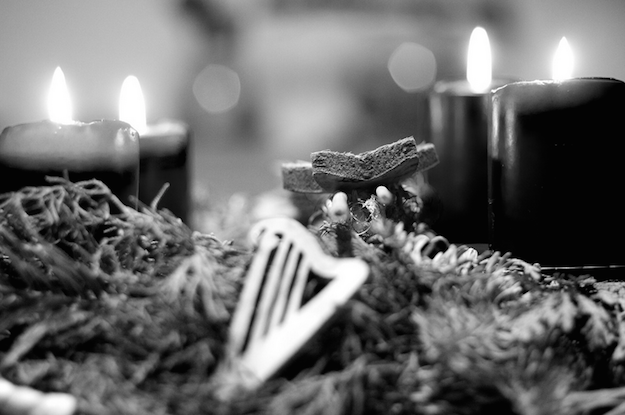Be on guard! Be alert! You do not know when that time will come. It’s like a man going away: He leaves his house and puts his servants in charge, each with their assigned task, and tells the one at the door to keep watch. Therefore keep watch because you do not know when the owner of the house will come back—whether in the evening, or at midnight, or when the rooster crows, or at dawn. If he comes suddenly, do not let him find you sleeping. What I say to you, I say to everyone: “Watch!” – Mark 13:32-37
Advent sells these days. In books, blogs, church programs, and Pinterest accounts, come the end of November, a growing number of evangelical-ish folk suddenly remember that the market(ers) and the state don’t get to set the calendar for us.
Our fascination with Advent might be a good thing – leading us out of the dark tug of consumerism and hopelessness and into the joy of Christ.
But it might also be a trap – keeping us stuck in the same emptiness we want to escape. Advent becomes a trap when we use it as an antidote (another kind of product we choose because of its usefulness) for our holiday malaise.
Advent, however, is not an antidote. It is the announcement of hope for the in-between. Antidotes treat problems, but Advent is a re-orienting event: not an anointment that soothes the pain so we can return to normal, but an announcement that re-orients and re-habituates our normal, in-between lives.
This leaves me asking, Why Advent? Of all the seasons of the church calendar, why are we so fascinated with this particular season? What does this trend reveal about us?
///
Fascination with Advent is a sign that we are, at some level, increasingly aware that the rhythms of our life – that is, our concrete, daily habits and practices – shape what we desire and matter for our formation. Implicitly, at least, we are feeling the dissonance that reverberates in our soul when our “beliefs” are out of sync with our practices. In other words, we’re waking-up to what happens when the means gets disconnected from the message.
A large Bible church near me, which guards as one of its core values the means a neutral vehicle for the message, has begun to use Advent as the primary form that shapes their worship services and branding during December. Puzzled by the apparent conflict I ask, “why name a particularly (ancient) Christian seasonal form as normative for the rhythms of the church if the message is not necessarily connected to a means of expression?”
Is it not that they know the gravitational pull from some cultural narratives – especially the holiday-consumption narrative – is so strong that resistance and abstinence is the best response? They know on the gut-level, like many of us, if we do not have an alternate means of inhabiting the world, we will be (de)formed by other other cultural narratives with their own means of inhabiting the world.
This is more basic than the desire to recover a sense of the sacred. What’s happening is that the holiday images dominating our age are becoming apocalyptically grotesque – unveiling how vicious, self-destructive, and empty the holiday market truly is and the extent to which those practices and desires have co-opted the practices of the church. So, many of us (not all consciously) have decided to bail.
Bailing from the emptiness out of old forms is a good thing, but there is a danger of bailing into a trap.
///
Advent is a potential trap because it can give us the impression we’re entering something new when all we have truly done is put a different coat of paint on old habits. We first reached for the glitter and Black Friday deals, but now we reach for an advent wreath. Yet the same emptiness remains.
We have slipped into the trap when we realize that Advent has become just one more thing to add to the mix of seasonal anxiety and stress. Our failed and feeble attempts to pull off Advent leave us feeling guilty and tired (as usual).
We have also slipped into the trap when, by some force of holiday will, we are actually able to muster enough energy to cram Advent into our daily circus. We might feel better about our accomplishment, but because we’ve done it in our own power and as an accessory to what is already there, Advent becomes a cheap boost to a false sense of fullness.
Advent becomes a trap when it is used as the antidote. “If you’re feeling sick of the holiday status quo, apply Advent here.” Advent is still a thing to do – a product to consume – with no real substance apart from its novelty. More significantly, when Advent is used as our holiday antidote, it can become the very thing that keeps us from actually being present to Immanuel.
It’s not just that there are many forces in the world sucking the life and light out of us (that is true enough on its own), and Advent is the antidote. It’s not just that, more than any other time during the year, our propensity to want and consume is evident (that is true enough on its own), and Advent is the antidote.
It’s that the in-between is a grueling place to be, but the voice of the one crying in the wilderness – the voice of the one from the margins where things aren’t quite realized – reverberates against the other voices that tell us self-preservation and self-indulgence are the best ways to cope with the reality of in-between.
Advent is the announcement of hope for the in-between…
In-between bondage to the empire and liberation from captivity.
In-between broken relationships.
In-between the act of oppression and the just verdict.
In-between jobs or paychecks.
In-between addiction and recovery.
In-between our present groaning and the redemption of our bodies.
In-between the First and Second Advent.
///
In-between is where we all exist, and where we learn how to be disciples. That is why the church year begins with Advent – because it all starts with learning how to name and inhabit where we truly are. It all starts with learning how to receive and proclaim the salvation that arrived in Jesus while waiting in the in-between – because we simply cannot be anywhere else. As Jesus exhorts his disciples in the Olivet Discourse, we must learn to watch and be attentive during the in-between.
Salvation-hope bursting forth in the darkness in Christ is the message of Advent and patient attentiveness to the hope amidst the in-between is the means. In-between is where we all exist, and where we learn how to be disciples. Click To Tweet
We know we’ve avoided the trap as Advent becomes a space where we can truly embrace the announcement of salvation-hope in the places where things aren’t quite realized. We know we’ve avoided the trap as Advent becomes a voice of hope for the in-between rather than the occasion for avoiding, silencing, or managing the in-between.
And Advent invites us to inhabit the in-between by waiting and watching – patient attentiveness to salvation-hope breaking forth in Christ on the margins and in positions of powerlessness.
Again, this is why Advent is our re-orienting point from the beginning of the year: we are learning to cultivate the way of Christ from a place of powerlessness (before or if we’re ever in charge) by waiting and watching right in the dirty mess of our in-between.
— [Image by Jannis Andrija Schnitzer, CC via Flickr]










Missio Alliance Comment Policy
The Missio Alliance Writing Collectives exist as a ministry of writing to resource theological practitioners for mission. From our Leading Voices to our regular Writing Team and those invited to publish with us as Community Voices, we are creating a space for thoughtful engagement of critical issues and questions facing the North American Church in God’s mission. This sort of thoughtful engagement is something that we seek to engender not only in our publishing, but in conversations that unfold as a result in the comment section of our articles.
Unfortunately, because of the relational distance introduced by online communication, “thoughtful engagement” and “comment sections” seldom go hand in hand. At the same time, censorship of comments by those who disagree with points made by authors, whose anger or limited perspective taints their words, or who simply feel the need to express their own opinion on a topic without any meaningful engagement with the article or comment in question can mask an important window into the true state of Christian discourse. As such, Missio Alliance sets forth the following suggestions for those who wish to engage in conversation around our writing:
1. Seek to understand the author’s intent.
If you disagree with something the an author said, consider framing your response as, “I hear you as saying _________. Am I understanding you correctly? If so, here’s why I disagree. _____________.
2. Seek to make your own voice heard.
We deeply desire and value the voice and perspective of our readers. However you may react to an article we publish or a fellow commenter, we encourage you to set forth that reaction is the most constructive way possible. Use your voice and perspective to move conversation forward rather than shut it down.
3. Share your story.
One of our favorite tenants is that “an enemy is someone whose story we haven’t heard.” Very often disagreements and rants are the result of people talking past rather than to one another. Everyone’s perspective is intimately bound up with their own stories – their contexts and experiences. We encourage you to couch your comments in whatever aspect of your own story might help others understand where you are coming from.
In view of those suggestions for shaping conversation on our site and in an effort to curate a hospitable space of open conversation, Missio Alliance may delete comments and/or ban users who show no regard for constructive engagement, especially those whose comments are easily construed as trolling, threatening, or abusive.